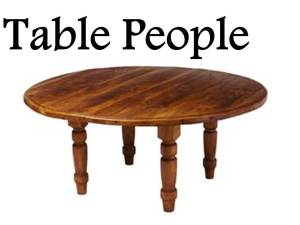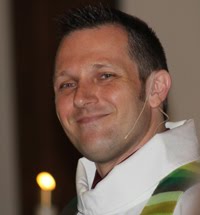I spent some time thinking about my grandmothers this week. One of my grandmother’s birthdays was on Tuesday, so I was thinking about these two women that have meant so much to me.
My grandmothers were table people.
Let me explain what I mean by that. My grandmothers lived in simple houses: one in south Pittsburgh and the other just east of the city. Two houses that I spent much of my childhood visiting. In both houses there were tables--tables that served as much more than a piece of furniture. At one house it filled the kitchen. At the other house it was a dining room table along with a picnic table on the back porch.
It was around those tables that life happened.
When I look back through old photo albums and silent super-8 home movies transferred to DVD, time after time I see images of our family gathered around those tables. Birthday parties, Thanksgiving dinners, Christmas Eve and Easter gatherings. Not to mention the daily routines that we never took pictures of: meals, conversations, homework sessions and card games.
There was nothing particularly striking about the tables. No one will want to take them to Antiques Roadshow. They were simple and modest--covered with the dents and scratches of years of use. Those tables, however, were at the heart of our family life together.
When you came into the house, there was always someone at the table. And there was always an open seat and an invitation. There was always a place at the table waiting.
Our history was created around those tables. Who we are as a family was formed around those tables.
My grandmothers were table people.
I remembered that particular aspect of my grandmothers as I prepared to gather today for Holy Trinity Sunday--the day that we celebrate the Triune God: the Father, the Son, and the Holy Spirit. It was in the 14th century that a Russian monk named Andrei Rublev painted an icon depicting the Holy Trinity. Many consider it to be the most perfect Russian Orthodox icon ever painted, and among the greatest pieces of sacred art ever produced.
 |
| "Trinity" by Andrei Rublev |
And what is really striking is that there is an empty place at the table. It’s arranged so that there’s an opening--a space at the table--for the person looking at the icon. There is a place at the table for you and for me.
700 years later we are surrounded by interactive images--high definition digital 3-D movies, TV, pictures and video games--but the Russian Orthodox Church was already producing interactive icons centuries ago! To gaze upon the icon of the trinity during prayer and worship was to gaze upon the relationship that forms the heart of God and to be drawn into the image, and into the relationship, through the invitation offered by the space at the table.
It is so very much like those tables that I remember from my grandmothers’ homes. Perhaps, I hope, it’s like a table you’ve sat around, too.
As Lutherans we don’t incorporate icons as a part of our tradition--although, as I look around this room, it's clear that we do appreciate images: whether painted on a wall, captured in stained glass, or projected on a screen.
While we may not incorporate icons into our faith community in the way that other Christians around the world do, we are, as the icon suggests, table people. We believe in a God who welcomes us to come sit at the table. We believe and proclaim an invitation into the very heart of God. We proclaim a God who is relationship--a God who wants to be in relationship with you, with us, with the world. We proclaim a God who provides a place at the table.
The idea of the Holy Trinity—the idea that the 1 God is at the same time 3 persons—is enough to make your head spin as you explore it. Contemplating the Holy Trinity can be a tremendously interesting and rewarding experience while also leaving you confused as every new insight reveals yet another layer of mystery and intrigue.
One of the simple basic truths about God as trinity that shines through all of the mystery and contemplation is that God’s nature is all about relationship. We hear it from the very beginning of the Biblical story. In Genesis chapter 1, God’s creation of everything is described--and in the middle of it all, God says, "Let us make humankind in our image.” The first Biblical image of God reflects the Trinity in conversation.
We hear Jesus, God in human skin, in the final paragraph of the gospel of Matthew compelling us to “Go therefore and make disciples of all nations, baptizing them in the name of the Father and of the Son and of the Holy Spirit.” Jesus sends us out to proclaim a God who is relationship; a God who wants to be in relationship with the world.
At its very heart, this command that we call “great commission” is all about being table people. At its very heart, the mission we share as a congregation: “To know Christ and make Christ known” is all about being table people.
Every time we approach the table--no matter where we are in our lives, no matter how strong or how fragile our faith is feeling--every time we approach the table there is a place for us.
We are table people because we have a table God. There is a spot at the table and it is open for you. Whatever is going on around that table, you are invited into it, welcomed, and expected to be a part of it. In the words of a wonderful old African American spiritual: “there’s plenty good room…just choose your seat and sit down!” It is when we sit down at the table—in a seat already there waiting for us--yhat we encounter the God who wants to be in relationship.
Now, please don’t hear all of this talk about God’s table and think that I’m talking only about Holy Communion. The radical and beautiful openness of God’s table is meant to be reflected in the meal we share here, but that is only one of many ways that we become table people.
As we gather around the table today we will then be sent out into the world. We are sent out with those words of the great commission still echoing in our souls: “Go therefore and make disciples of all nations.” As people who have come to know Christ, we are sent to make Christ known. Having found that we have a place at the table, we become people who extend God’s table. We create a place for the person looking in from the outside. We look up from the table and offer a place that is already waiting.
We can do it here at the table of Holy Communion (and we need to). We can do it in in the fellowship of this congregation gathered to worship (and we need to), but God wants us to be table people every day.
God didn't send Jesus into the world to teach us how to be good churchgoers. God didn't send Jesus into the world to teach us how to do religion right. God sent Jesus into the world to teach us how to be human beings--how to love one another and extend what has God has given us every single day. God wants us to find the person looking in from the outside and extend every table that we have found our own place at.
Table people open up their tables to everyone who walks in the door. Table people make room in their lives for everyone they encounter. You don’t need a fancy table. You don’t need a good looking table. God invites you to extend whatever table it is that you are sitting at. Table people encounter a God who is relationship. Table people are drawn into relationship with God and one another so that we can extend that same experience of love and grace to the world around us.
Table people know Christ and make Christ known. Table people experience and share the love of God.
Table people is what we are called to be, because being table people is at the heart of the good news of the gospel.
Amen.



1 comment:
That's a very fine sermon.
Post a Comment